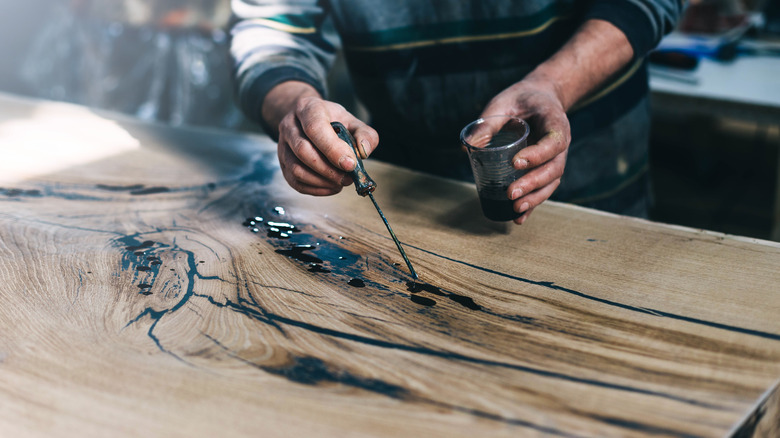TikTok's Genius Epoxy Hack For Filling Wood Knot Holes In Your Tables
When you're woodworking, keeping your wood free of defects like knot holes, cracks, and gaps is vital not only for aesthetic reasons but also for maintaining structural integrity — defects like dead knots can significantly impact your wood's strength. Sealing wood is essential, especially for surfaces like tables that can trap food particles and liquids, potentially resulting in bacterial growth.
Some folks spring for wood filler (or even make their own) to solve this issue, but filling wood holes and cracks with epoxy is also a popular solution. This method adds to the wood's aesthetic appeal while also giving it a solid finish; however, working with epoxy can become messy if done incorrectly. Fortunately, TikTok user @byotools shared a hack to help with this mess: Just create a barrier around the hole with hot glue before pouring your epoxy.
When sealing a hole with epoxy, it's crucial that you first seal any gaps in the wood's bottom and sides with tape to ensure that the epoxy is contained. Some people take the additional step of placing tape around the hole. This confines the epoxy to the desired area and makes peeling off the excess easy. The hack from @byotools aligns with this approach. By creating a barrier with hot glue, woodworkers can effectively prevent the epoxy from spilling and spreading uncontrollably.
Why the hot glue epoxy hack may be unnecessary
While TikTok's hot glue epoxy hack may be effective, is it really necessary? In many woodworking projects of this nature, like the popular (but challenging) DIY epoxy table trend, an excess of epoxy on the wood's surface is rarely cause for concern. This is because overfilling ensures complete coverage of every crack and void. At the same time, other simple strategies can prevent the liquid from overspreading, like using smaller epoxy applicators, adjusting your application technique, or tweaking the epoxy resin mix so it's not too runny.
Many woodworkers even purposefully overfill defects with epoxy, as this ensures that any air bubbles stay on the wood's surface, not in the cracks. This doesn't pose a problem because, later in the woodworking process, you'll sand or plane the surface, removing any excess product. There is, however, one good reason to use TikTok's hot glue hack: Creating a barrier and overfilling the void with epoxy helps compensate for uneven surfaces. The hot glue acts as a buffer zone, allowing the material to build up without wasting excess epoxy resin that will be hard to dispose of correctly.
